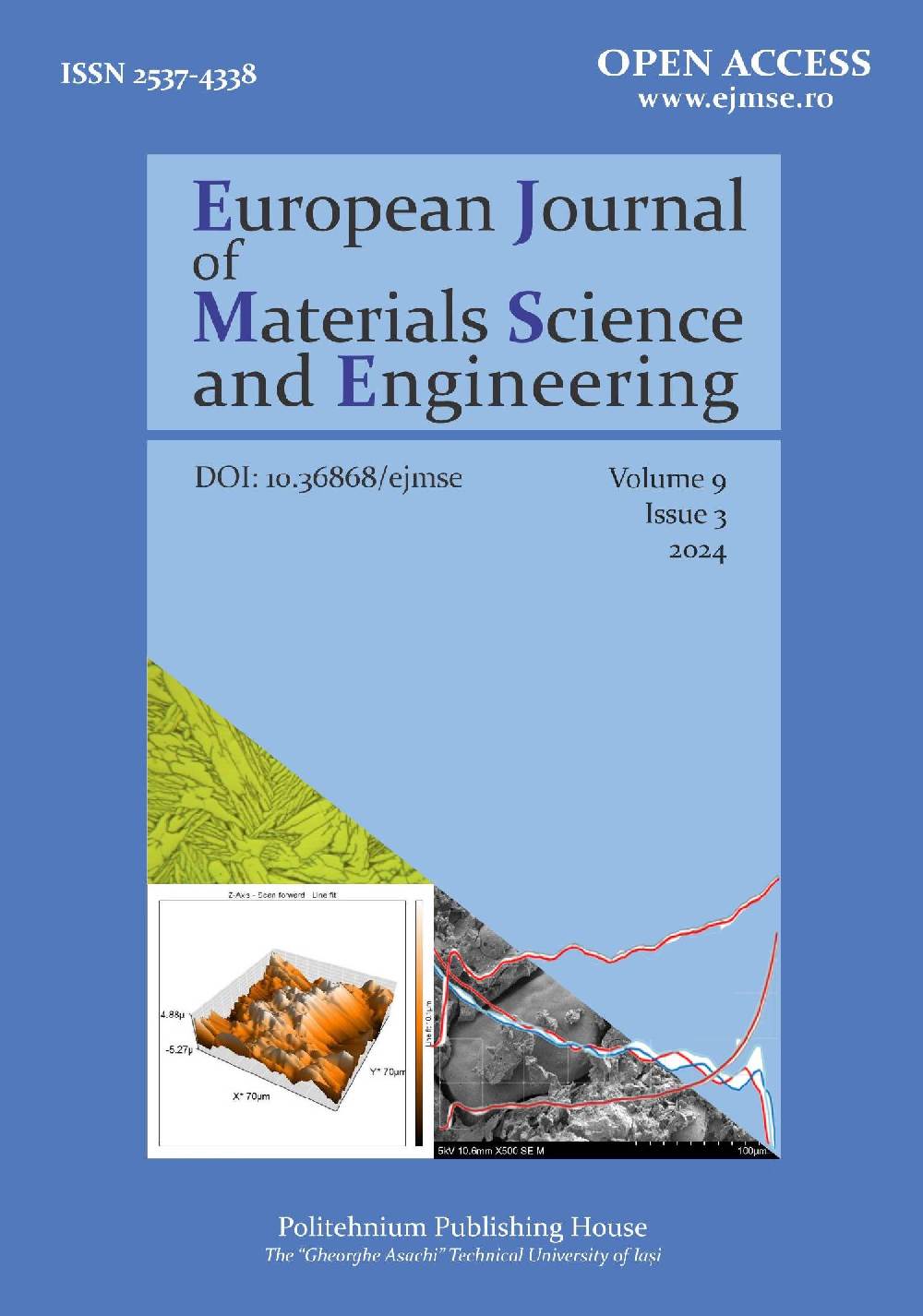INNOVATIVE EXPERIMENTAL TESTING PROGRAM OF DIRECT SHEAR TEST IN SOIL MECHANICS
European Journal of Materials Science and Engineering, Volume 9, Issue 3, 2024
PDF Full Article, DOI: 10.36868/ejmse.2024.09.03.231, pp. 231-242
Zakaria OWUSU-YEBOAH 1,*, Mircea ANICULAESI 1, Andreea Vasilica DASCALU 1, Iancu Bogdan TEODORU 1, Irina LUNGU 1
1Faculty of Civil Engineering and Building Services, Gheorghe Asachi Technical University of Iasi, 67 Prof. D. Mangeron Blvd, RO-700050 Iasi, Romania
* Corresponding author: zakaria.owusu-yeboah@student.tuiasi.ro
Abstract
The research work aims at analyzing for the first time the data set obtained on cohesive soil samples following the publication of the Romanian Invention Patent RO 134239. The standard test method for the direct shear test provides the shear strength parameter – internal friction angle in consolidated drained condition – of either undisturbed or remolded soil samples forcing the shear plane at the midsection of the sample in the horizontal direction. The samples are provided in parallelepipedal shape (6 cm x 6 cm x 2 cm) and the displacement rate in horizontal direction is 0.1 mm/min. The new equipment patented in Romania changes the direction of shearing, from horizontal to vertical, and the soil samples are of cubic shape (6 cm x 6 cm x 6 cm). The experimental program involves testing both the parallelepipedal and cubic samples using the same motorized mechanism, with simultaneous readings from their respective micro-comparators. The UU test is performed without allowing consolidation and shearing at 1.0 mm/min. For the CD test, samples are consolidated under vertical loads for 24 hours before shearing at 0.1 mm/min. The shear stresses for cubic samples were higher than those for parallelepipedal samples, with residual stresses reflecting this trend. For cubic samples, both the peak and residual shear stresses trend lines indicated higher cohesion (c) and lower internal friction angle () for UU tests and CD tests in contrast to parallelepipedal samples in both testing conditions. The innovative testing program allows for variability in shear strength parameters along the soil failure surface in both natural and compacted soil structures. This differentiation divides the soil condition into drained and undrained states at the initiation, emergence points, and the point of maximum depth along the failure surface. This approach is significant for accurately assessing soil shear resistance and potential failure mechanisms. The study’s findings suggest a nuanced approach to parameter selection for slope stability analysis, ensuring accurate representation of both cohesion and internal friction in stability models.
Keywords: direct shear test, shear strength parameters, soil mechanics, soil cohesion, internal friction angle.
References:
[1] K. Terzaghi, R.B. Peck, Soil Mechanics in Engineering Practice. s.l.: John Wiley & Sons, 1948.
[2] O.N. Isaev, R.F Sharafutdinov, Soil Shear Strength at the Structure Interface. Soil Mech Found Eng, Vol. 57, 2020, p. 139–146.
[3] Y. Yu-qiu, H. Jie, R. Rui., Assessment of Analytical Solutions for Calculating Lateral Earth Pressures Behind Rigid Retaining Walls Under Translational Movement. Geotechnical and Geological Engineering, Vol. 42, 2024, p. 2901-2919.
[4] B. Tiwari, B. Ajmera, Advancements in Shear Strength Interpretation, Testing, and Use for Landslide Analysis., Progress in Landslide Research and Technology, Vol. 2, 2023 p. 3-54.
[5] S.H Jiang, H. Jinsong, Q. Xiao-Hui, Z. Chuang-Bing, Efficient probabilistic back analysis of spatially varying soil parameters for slope reliability assessment. Engineering Geology, Vol. 271, 2020, p. 105597.
[6] M. Axel, X. Li, F. Wen, M.X An, Microstructure and Strength Parameters of Cement-Stabilized Loess. Geotechnics, Vol. 3, 2023, p. 161-178.
[7] H. Imran, D. Al-Jeznawi, M.A.Q. Al-Janabi, L.F.A. Bernardo, Assessment of Soil–Structure Interaction Approaches in Mechanically Stabilized Earth Retaining Walls: A Review. 3, CivilEng, Vol. 4, 2023, p. 982-999.
[8] K. H. Head, R.J. Epps, Manual of Soil Laboratory Testing, Volume 2: Permeability, Shear Strength and Compressibility Tests. 3rd. Caithness: Whittles Publishing, 2011.
[9] J. Bai, D. Yu, J. Chenhang, L. Chongyang, Z. Menghan, C. Wang, A Review of Advances in Triaxial Tests: Instruments, Test Techniques and Prospects. KSCE J Civ Eng, Vol. 26, 2022, p. 3325–3341.
[10] B. James, Unconfined Compression Test of Soil. [A Descriptive Guide]. Civil Seek. December 11, 2018.
[11] ASTMD6467, Standard, Standard Test Method for Torsional Ring Shear Test to Determine Drained Residual Shear Strength of Fine-Grained Soils. 2021, ASTM International.
[12] D. White, Geotechnical centrifuge modelling – current practice. 2020, Physical Models: Their historical and current use in civil and building engineering design.
[13] S.W. Moon, T. Ku, Empirical estimation of soil unit weight and undrained shear strength from shear wave velocity measurements. Australian Geomechanics Society, 2016, p. 1247-1252.
[14] B.E. Backus, GlobalGilson.com. [Online] n.d. [Cited: June 17, 2024.] https://www.globalgilson.com/blog/soil-direct-shear-test.
[15] N.R. MacDonald, T.R.M. Packulak, J.J. Day, A Critical Review of Current States of Practice in Direct Shear Testing of Unfilled Rock Fractures Focused on Multi-Stage and Boundary Conditions. 6, Geosciences, Vol. 13, 2023, p. 172.
[16] X. Shiqing, Y. Ben-Zion, J.P. Ampuero, Properties of inelastic yielding zones generated by in-plane dynamic ruptures—I. Model description and basic results. Geophysical Journal International, 2012, p. 1325–1342.
[17] P. Buck, Soil Mechanics Vol 1. 1. Vero Beach: Pile Buck International, Inc., 2023.
[18] A. Stanciu, I. Lungu, Foundations Vol I – Soil Physics and Mechanics. Bucharest: Technical Publishing House, 2006.
[19] A. Stanciu, I.C. Herta, C. Predoaie, Device for direct shear along on imposed vertical plan of soil samples. 134239 Romania, 2020.
[20] L. Zhu, Q. Liao, Z. Wang, J. Chen, Z. Chen, Q. Bian, Q. Zhang, Prediction of Soil Shear Strength Parameters Using Combined Data and Different Machine Learning Models. 10, Applied Sciences, Vol. 12, 2022, p. 5100.
